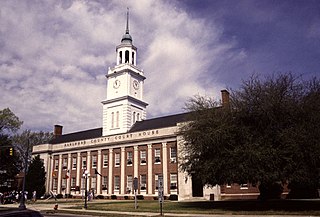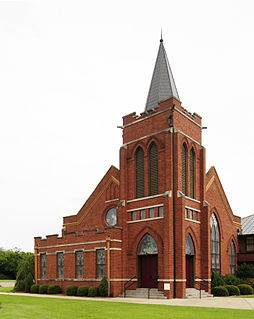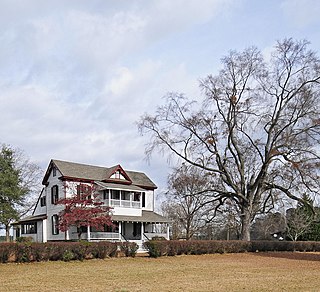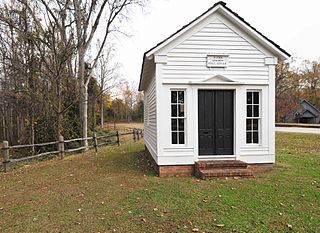
Bennettsville is a city located in the U.S. state of South Carolina on the Great Pee Dee River. As the county seat of Marlboro County, Bennettsville is noted for its historic homes and buildings from the 19th and early 20th centuries — including the Bennettsville Historic District which is listed on the National Register of Historic Places.

Clio is a town in Marlboro County, South Carolina, United States. The population was 726 at the 2010 census. Marlboro School of Discovery is a magnet school in Clio, South Carolina and is part of the Marlboro County School District.

This is a list of the National Register of Historic Places listings in Marlboro County, South Carolina.

East Home Avenue Historic District is a national historic district located at Hartsville, Darlington County, South Carolina. The district encompasses 52 contributing buildings and 1 contributing site in a primarily residential section of Hartsville. They were constructed between about 1890 to about 1938, and is associated with the leading figures of the town's history. Home Avenue has historically been the major residential street in Hartsville since it was laid out and landscaped in 1890. Architectural styles and influences include Renaissance Revival, Colonial Revival, Classical Revival, American Craftsman, and Bungalow. Notable non-residential buildings include the First Baptist Church, Thornwell Elementary School, and Hartsville Public School. Located in the district is the separately listed John L. Hart House.

Cool Springs is a historic home located near Camden, Kershaw County, South Carolina. It was built about 1832, and is a two-story Greek Revival style house on a raise brick basement. The original house was remodeled in the 1850s. It features a tiered portico and verandahs, supported by 64 Doric order columns. A two-story kitchen addition was attached to the house about 1935. Also on the property are the contributing two horse stables, a concrete piscatory, an old stone spring, a brick basin, a dam, and granite gate posts.

East Richland Street-East Church Street Historic District is a national historic district located at Kershaw, Lancaster County, South Carolina. It encompasses 28 contributing buildings in a residential section of Kershaw. The majority of the residences date from about 1890 to 1920, a particularly significant period of development in Kershaw. The houses are in a variety of representative architectural styles include Victorian, Queen Anne, Colonial Revival, and Neo-Classical.

Matson Street Historic District is a national historic district located at Kershaw, Lancaster County, South Carolina. It encompasses 26 contributing buildings in a residential section of Kershaw. The majority of the buildings date from about 1890 to 1940, a particularly significant period of development in Kershaw. The houses are in a variety of representative architectural styles include Victorian, Queen Anne, Bungalow, American Craftsman, Colonial Revival, and Neo-Classical. Also located in the district is the First Presbyterian Church.

South Harper Historic District is a national historic district located at Laurens, Laurens County, South Carolina. It encompasses 44 contributing buildings in a residential section of Laurens. It includes a collection of early-20th century vernacular residences and houses that range in date from the early-19th century to about 1935, with almost half having been built during the first decade of the 20th century. Architectural styles include Neo-Classical, Queen Anne, Colonial Revival, and Bungalow. Notable dwellings include the Hix-Blackwell House, H. Douglas Gray House, Machen-Long House, and Gov. Robert Archer Cooper House.

Church Street Historic District is a national historic district located at Batesburg-Leesville, Lexington County, South Carolina. It encompasses nine contributing buildings in a residential section of Leesville. They were largely constructed between about 1865 and 1909, with one house built after 1910. The district includes the Gothic Revival style Leesville Methodist Church (1909) and notable Italianate and Queen Anne style residences.

McLaurin House, also known as the Lamar McLaurin House, is a historic home located near Clio, Marlboro County, South Carolina. It was built about 1880, and is a two-story clapboard Italianate style frame dwelling. It has a truncated hip roof with a balustraded deck. The front façade features a one-story porch with balustrade and decorative brackets. Also on the property are three contributing outbuildings.

McLaurin-Roper-McColl Farmstead, also known as Broad Oaks, is a historic home and farmstead located near Clio, Marlboro County, South Carolina. The original section of the house was built about 1826, as a four-bay side-gable cottage. Additions were made to the structure about 1850 and 1899, with American Craftsman style modifications made in the 1920s. Also on the property are an early outbuilding, African American cemetery, farm roads, and built landscape features such as drainage ditches.

Little Mountain Historic District is a national historic district located at Little Mountain, Newberry County, South Carolina. The district encompasses 50 contributing buildings and 2 contributing structures in the railroad town of Little Mountain. The buildings date from about 1890 to 1950 and include residences, businesses, and other institutional buildings. They include examples of the Gothic Revival, Neo-Classical, Colonial Revival, Victorian or Queen Anne, and Bungalow styles.

Columbia Historic District II is a national historic district located at Columbia, South Carolina. The district encompasses 113 contributing buildings and 1 contributing site in a former residential section of Columbia. They were built between the early-19th century and the 1930s and are now mostly used for commercial purposes. The buildings are in the Greek Revival, Gothic Revival, Classical Revival, and the “Columbia Cottage” styles. Notable buildings include the Robert Mills House, Debruhl-Marshall House, Hampton-Preston House, Episcopal Church of the Good Shepherd, Crawford-Clarkson House, Maxcy Gregg House, Hale-Elmore-Seibels House, St. Paul's Lutheran Church, and Ebenezer Lutheran Church.

Glenn Springs Historic District is a national historic district located at Glenn Springs, Spartanburg County, South Carolina. It encompasses 18 contributing buildings and 3 contributing sites in the historic health resort of Glenn Springs. The community developed as a resort around the mineral springs between about 1840 and 1940. The district includes several residences, two boarding houses, Cates House Ruins, Calvary Protestant Episcopal Church, Presbyterian Church, Cates Store, Glenn Springs Post Office, a pavilion, a cemetery, and the site of the Glenn Springs Hotel. It includes notable buildings in the Greek Revival, Gothic Revival, Queen Anne, and Bungalow styles.

Mayesville Historic District is a national historic district located at Mayesville, Sumter County, South Carolina. It encompasses 62 contributing buildings in the western half of the town of Mayesville. It includes a broad range of late-19th and early-20th century vernacular architectural design, including commercial, residential (majority), and religious buildings. The district includes representative examples of the Neo-Classical, Victorian, Queen Anne, Colonial Revival, Greek Revival, and Bungalow. Notable buildings include the Town Hall, Kineen Hotel, Bland Stables, Granit Building, Davis Store, J. W. Rhodes House, and R. J. Mayes House.

South Street–South Church Street Historic District is a national historic district located at Union, Union County, South Carolina. The district encompasses 78 contributing buildings in a primarily residential section of Union. The houses were built between about 1850 to about 1930, with the majority dating from about 1850 to about 1915. The district includes many large-frame Queen Anne inspired houses built about 1880–1910. Also in the district are Neo-Classical, Gothic Revival, Colonial Revival, Tudor Revival, American Foursquare, and Bungalow style dwellings. The district includes the first Carnegie Library established in South Carolina.

Marion Street Area Historic District is a national historic district located at Rock Hill, South Carolina. It encompasses 28 contributing buildings and 1 contributing site in a middle-class residential section of Rock Hill. The bulk of the district developed between 1906 and 1925. Architectural styles represented include Victorian, Classical Revival, Colonial Revival, and Bungalow. Notable buildings include the Rawlinson House, McCall-Jones-Byrant House, Davis House, and W. B. Jenkins House.

Hampton–Pinckney Historic District is a national historic district located at Greenville, South Carolina. It encompasses 70 contributing buildings in a residential section of Greenville. The houses date from about 1890 to 1930, and include Italianate, Greek Revival, Queen Anne, various bungalows, and examples of Gothic Revival and Colonial Revival design, as well as vernacular forms. The oldest house in the district is the McBee House.

Col. Elias Earle Historic District is a national historic district located at Greenville, South Carolina. It encompasses 74 contributing buildings in a middle-class neighborhood of Greenville. The houses primarily date from about 1915 to 1930, and include Neoclassical, Colonial Revival, Tudor Revival, and bungalow styles. The district was originally part of the estate of Colonel Elias Earle, a prominent early-19th century Greenville citizen. The Earle St. Baptist Church is located in the district.

Secessionville Historic District is a national historic district located near Folly Beach, Charleston County, South Carolina. It extends into the city of Charleston, South Carolina. The district encompasses six contributing buildings, one contributing site, and one contributing site in Secessionville. The district includes the summer homes of several leading James Island planters, the site of the American Civil War Battle of Secessionville, the unmarked grave of over 300 Union soldiers, and the remains of Fort Lamar, constructed about 1862.























